项目一——均衡价格理论及弹性理论的应用(更新版)
- 格式:ppt
- 大小:1.77 MB
- 文档页数:90
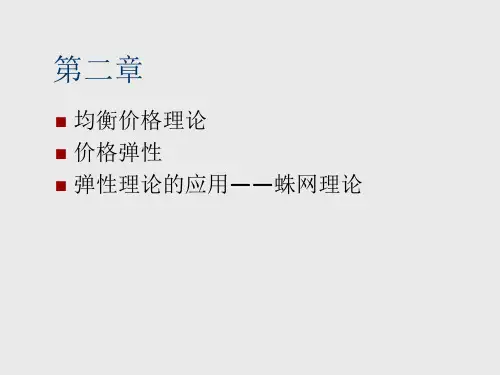



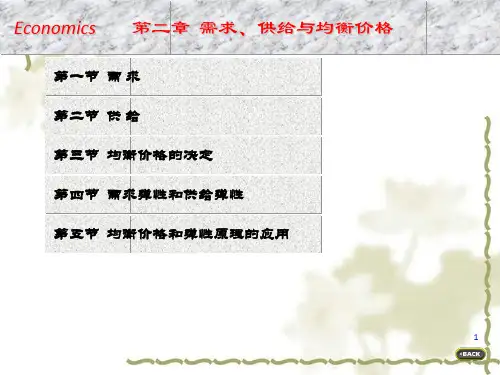
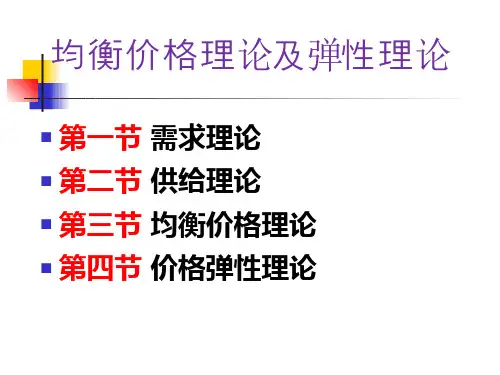
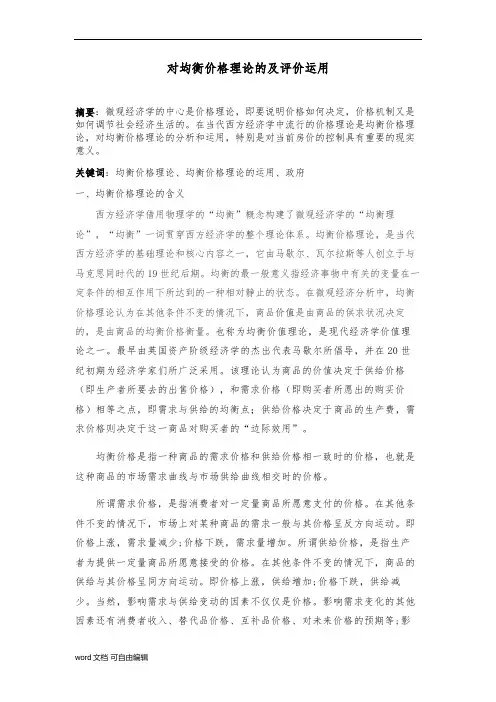
对均衡价格理论的及评价运用摘要:微观经济学的中心是价格理论,即要说明价格如何决定,价格机制又是如何调节社会经济生活的。
在当代西方经济学中流行的价格理论是均衡价格理论,对均衡价格理论的分析和运用,特别是对当前房价的控制具有重要的现实意义。
关键词:均衡价格理论、均衡价格理论的运用、政府一、均衡价格理论的含义西方经济学借用物理学的“均衡”概念构建了微观经济学的“均衡理论”,“均衡”一词贯穿西方经济学的整个理论体系。
均衡价格理论,是当代西方经济学的基础理论和核心内容之一,它由马歇尔、瓦尔拉斯等人创立于与马克思同时代的19世纪后期。
均衡的最一般意义指经济事物中有关的变量在一定条件的相互作用下所达到的一种相对静止的状态。
在微观经济分析中,均衡价格理论认为在其他条件不变的情况下,商品价值是由商品的供求状况决定的,是由商品的均衡价格衡量。
也称为均衡价值理论,是现代经济学价值理论之一。
最早由英国资产阶级经济学的杰出代表马歇尔所倡导,并在20世纪初期为经济学家们所广泛采用。
该理论认为商品的价值决定于供给价格(即生产者所要去的出售价格),和需求价格(即购买者所愿出的购买价格)相等之点,即需求与供给的均衡点;供给价格决定于商品的生产费,需求价格则决定于这一商品对购买者的“边际效用”。
均衡价格是指一种商品的需求价格和供给价格相一致时的价格,也就是这种商品的市场需求曲线与市场供给曲线相交时的价格。
所谓需求价格,是指消费者对一定量商品所愿意支付的价格。
在其他条件不变的情况下,市场上对某种商品的需求一般与其价格呈反方向运动。
即价格上涨,需求量减少;价格下跌,需求量增加。
所谓供给价格,是指生产者为提供一定量商品所愿意接受的价格。
在其他条件不变的情况下,商品的供给与其价格呈同方向运动。
即价格上涨,供给增加;价格下跌,供给减少。
当然,影响需求与供给变动的因素不仅仅是价格。
影响需求变化的其他因素还有消费者收入、替代品价格、互补品价格、对未来价格的预期等;影响供给变化的其他因素还有生产技术水平、生产要素价格、相关商品价格等。
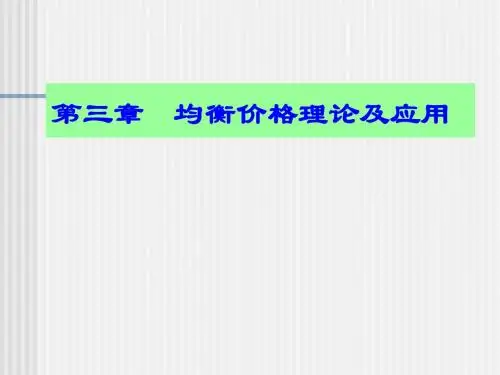
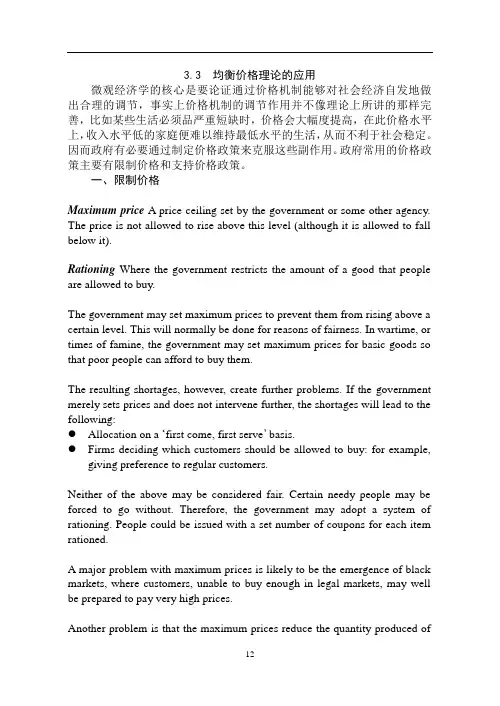
3.3 均衡价格理论的应用微观经济学的核心是要论证通过价格机制能够对社会经济自发地做出合理的调节,事实上价格机制的调节作用并不像理论上所讲的那样完善,比如某些生活必须品严重短缺时,价格会大幅度提高,在此价格水平上,收入水平低的家庭便难以维持最低水平的生活,从而不利于社会稳定。
因而政府有必要通过制定价格政策来克服这些副作用。
政府常用的价格政策主要有限制价格和支持价格政策。
一、限制价格Maximum price A price ceiling set by the government or some other agency. The price is not allowed to rise above this level (although it is allowed to fall below it).Rationing Where the government restricts the amount of a good that people are allowed to buy.The government may set maximum prices to prevent them from rising above a certain level. This will normally be done for reasons of fairness. In wartime, or times of famine, the government may set maximum prices for basic goods so that poor people can afford to buy them.The resulting shortages, however, create further problems. If the government merely sets prices and does not intervene further, the shortages will lead to the following:●Allocation on a ‘first come, first serve’ basis.●Firms deciding which customers should be allowed to buy: for example,giving preference to regular customers.Neither of the above may be considered fair. Certain needy people may be forced to go without. Therefore, the government may adopt a system of rationing. People could be issued with a set number of coupons for each item rationed.A major problem with maximum prices is likely to be the emergence of black markets, where customers, unable to buy enough in legal markets, may well be prepared to pay very high prices.Another problem is that the maximum prices reduce the quantity produced ofan already scarce commodity.To minimize these types of problem the government may attempt to reduce the shortage by encouraging supply: by drawing on stores, by direct government production, or by giving subsidies or tax relief to firms. Alternatively, it may attempt to reduce demand: by the production of more alternative goods or by controlling people’s incomes.Minimum price A price floor set by the government or some other agency. The price is not allowed to fall below this level (although it is allowed to rise above it).Black markets Where people ignore the government’s price and/or quantity controls and sell illegally at whatever price equates illegal demand and supply. The government sets minimum prices to prevent them from falling below a certain level. It may do this for various reasons:●To protect producer s’ incomes.●To create a surplus, e.g. grains. Particular in periods of glut, which can bestored in preparation for possible future shortages.●In the case of wages (the price of labor), minimum wage legislations canbe used to prevent workers’ wage rates from falling below a certain level. The government can use various methods to deal with the surpluses associated with minimum prices.●The government could buy the surplus and store it, destroy it or sell itabroad in another markets.●Supply could be artificially lowered by restricting producers to particularquotas.●Demand could be raised by advertising, by finding alternative uses for thegoods, or by reducing consumption of substitute goods (e.g. by imposing taxes or quotas on substitutes, such as imports).One of the problems with minimum prices is that firms with surpluses on their hands may try to evade the price control and cut their prices.Another problem is that high prices may cushion inefficiency. Firms may feel less need to find more efficient methods of production and to cut their costs iftheir profits are being protected by the high price. Also the high price may discourage firms from producing alternative goods which they could produce more efficiently or which are in higher demand, but which nevertheless have a lower price.限制价格是指政府为了限制某些生活必需品的物价上涨而规定的这些商品的最高价格,限制价格低于市场均衡价格。

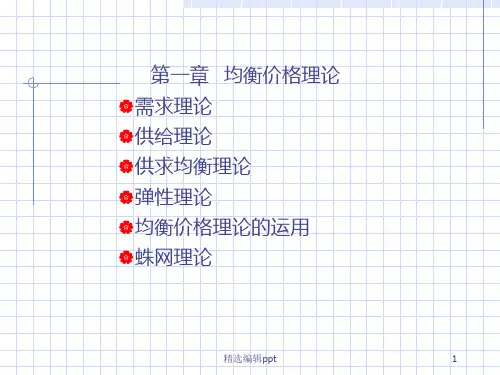
价格弹性理论与均衡理论价格弹性理论与均衡理论是经济学中两个重要的理论概念。
它们对于市场经济中价格的变动和市场的均衡状态有着重要的解释和影响。
价格弹性理论是指价格变动对需求量变动的敏感程度。
根据价格弹性的大小,可以判断商品的需求对价格变动的敏感程度。
价格弹性大的商品,说明消费者对该商品的需求变动较为敏感,对价格变动的反应较强烈;而价格弹性小的商品,说明消费者对该商品的需求变动不敏感,对价格变动的反应较弱。
价格弹性的大小可以通过计算需求量变动的百分比与价格变动的百分比之比来得出。
价格弹性理论的主要应用之一就是在市场策略制定和定价决策中,帮助企业预测和控制市场需求的变动。
均衡理论是指市场供求关系达到最优状态的一种理论。
均衡状态是指市场供给量等于市场需求量,此时市场达到了供求的平衡状态。
在均衡状态下,市场价格能够达到一个稳定的水平,同时供求双方的利益都能得到最大化。
均衡理论的主要应用之一是在市场调节和政府干预中,发挥市场机制的作用,使市场达到均衡状态,实现资源的有效配置。
价格弹性理论和均衡理论在市场经济中相互作用和影响。
价格弹性理论可以用来解释价格变动对市场需求的影响,判断市场需求对价格变动的敏感度,从而指导企业定价和市场策略制定。
而均衡理论则可以帮助理解市场供求关系的最优状态,以及达到这一状态的调节机制和政策措施。
两者相互补充,共同协调市场经济中的供求关系和价格变动,实现市场资源的有效配置。
总之,价格弹性理论和均衡理论是经济学中对于价格变动和市场均衡状态的重要解释方法和工具。
它们为市场经济中的定价和资源配置提供了理论基础和指导。
在现代市场经济中,理解和应用这两个理论对于企业和政府来说都具有重要的意义。
价格弹性理论和均衡理论是经济学中两个重要的理论概念,对于市场经济中价格的变动和市场的均衡状态有着重要的解释和影响。
本文将进一步探讨这两个理论并探讨其相关性。
首先来看价格弹性理论。
价格弹性理论是指价格变动对需求量变动的敏感程度。